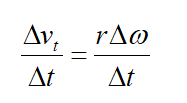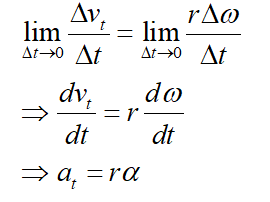(d) If this changes takes place in some small At and if we divide both sides of the equation Avr = rAw by At, justify that we will get at = ra, where a is called the tangential acceleration and a is the rigid body angular acceleration. Most importantly, for example, this result tells us the relationship between the angular acceleration of the wheel of the car and the linear acceleration of the car. (e) When an object is under a rotational motion or circular motion, that object besides contains tangential acceleration it also has centripetal acceleration as well. In the figure below, for example, the child on the merry-go-round has both tangential and centripetal acceleration. The equation for the centripetal acceleration is a, = v7/r (we are not going to derive this equation), and its direction of acceleration is toward the center. Using Newton's second law, this gives the centripetal force as F = mag or Fep = . Does this make sense? What is the direction of the centripetal force on the child?
(d) If this changes takes place in some small At and if we divide both sides of the equation Avr = rAw by At, justify that we will get at = ra, where a is called the tangential acceleration and a is the rigid body angular acceleration. Most importantly, for example, this result tells us the relationship between the angular acceleration of the wheel of the car and the linear acceleration of the car. (e) When an object is under a rotational motion or circular motion, that object besides contains tangential acceleration it also has centripetal acceleration as well. In the figure below, for example, the child on the merry-go-round has both tangential and centripetal acceleration. The equation for the centripetal acceleration is a, = v7/r (we are not going to derive this equation), and its direction of acceleration is toward the center. Using Newton's second law, this gives the centripetal force as F = mag or Fep = . Does this make sense? What is the direction of the centripetal force on the child?
College Physics
11th Edition
ISBN:9781305952300
Author:Raymond A. Serway, Chris Vuille
Publisher:Raymond A. Serway, Chris Vuille
Chapter1: Units, Trigonometry. And Vectors
Section: Chapter Questions
Problem 1CQ: Estimate the order of magnitude of the length, in meters, of each of the following; (a) a mouse, (b)...
Related questions
Question
can you answer parts d and e please?

Transcribed Image Text:7. When a rigid body rotates about a fixed axis, every particle in the body moves in a circular path.
As shown in the figure below, the arclength As between the angular positions 6, and 82 is given as
As = rA8. Do you agree with this equation?
rotational motion
(a) In the limit where A6 is very small, then As can be
consider as a straight line. Is this true or false?
AsrAe
(b) It follows from statement (a) that any points along the
circular path there is a tangential velocity (vr) that is
always perpendicular to the radius of the rotating body.
Hence, if we divide both sides of the equation As = rAe
by At, justify that we will get v = rw. This result indicates
that the direction of the particle's velocity is tangential
to its circular path at each point. Most importantly, for example, this result tells us the relation-
ship between the angular velocity of the wheel of the car and linear velocity of the car.
Reference line
At
(c) If the angular velocity changes by Aw, then the rotating object's linear speed will change by Avr.
Hence, we will have Aer = rAw. Is this a true statement?
(d) If this changes takes place in some small At and if we divide both sides of the equation Av = rAw
by At, justify that we will get at = ra, where a is called the tangential acceleration and a is the
rigid body angular acceleration. Most importantly, for example, this result tells us the relationship
between the angular acceleration of the wheel of the car and the linear acceleration of the car.
(e) When an object is under a rotational motion or circular motion, that object besides contains
tangential acceleration it also has centripetal acceleration as well. In the figure below, for example,
the child on the merry-go-round has both tangential and centripetal acceleration. The equation
for the centripetal acceleration is ap = v7/r (we are not going to derive this equation), and its
direction of acceleration is toward the center. Using Newton's second law, this gives the centripetal
force as Fep = map or Fep = . Does this make sense? What is the direction of the centripetal
force on the child?
Expert Solution
Step 1
d)
The given equation is,

Here, Δvt, r, and Δω represent the change in the tangential velocity, the circular path’s radius, and the change in angular velocity, respectively.
Dividing both sides by a small-time interval Δt.
Thus,

Now, for the time interval to be very small, that is, approaching 0,

Here, at and α represent the tangential acceleration, and angular acceleration, respectively.
Step by step
Solved in 2 steps with 7 images

Knowledge Booster
Learn more about
Need a deep-dive on the concept behind this application? Look no further. Learn more about this topic, physics and related others by exploring similar questions and additional content below.Recommended textbooks for you

College Physics
Physics
ISBN:
9781305952300
Author:
Raymond A. Serway, Chris Vuille
Publisher:
Cengage Learning

University Physics (14th Edition)
Physics
ISBN:
9780133969290
Author:
Hugh D. Young, Roger A. Freedman
Publisher:
PEARSON

Introduction To Quantum Mechanics
Physics
ISBN:
9781107189638
Author:
Griffiths, David J., Schroeter, Darrell F.
Publisher:
Cambridge University Press

College Physics
Physics
ISBN:
9781305952300
Author:
Raymond A. Serway, Chris Vuille
Publisher:
Cengage Learning

University Physics (14th Edition)
Physics
ISBN:
9780133969290
Author:
Hugh D. Young, Roger A. Freedman
Publisher:
PEARSON

Introduction To Quantum Mechanics
Physics
ISBN:
9781107189638
Author:
Griffiths, David J., Schroeter, Darrell F.
Publisher:
Cambridge University Press

Physics for Scientists and Engineers
Physics
ISBN:
9781337553278
Author:
Raymond A. Serway, John W. Jewett
Publisher:
Cengage Learning

Lecture- Tutorials for Introductory Astronomy
Physics
ISBN:
9780321820464
Author:
Edward E. Prather, Tim P. Slater, Jeff P. Adams, Gina Brissenden
Publisher:
Addison-Wesley

College Physics: A Strategic Approach (4th Editio…
Physics
ISBN:
9780134609034
Author:
Randall D. Knight (Professor Emeritus), Brian Jones, Stuart Field
Publisher:
PEARSON